|
|
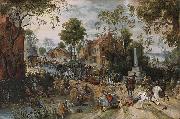 |
Sebastiaen Vrancx
|
|
(22 January 1573 - 19 May 1647) was a Flemish Baroque painter and etcher of the Antwerp school.
He was an apprentice in the workshop of Adam van Noort, who also trained many illustrious painters such as Peter Paul Rubens, Jacob Jordaens and Hendrik van Balen. He also visited the workshop of the Antwerp painter Paul Bril in Rome around 1600.
He was esteemed as one of the main painters of battle scenes, and works by Vranckx were in the collection of Peter Paul Rubens. As a collaborator he worked at times with Jan Brueghel the Elder. and together with Rubens, Frans Francken the Younger, van Balen, Frans Snyders and Joos de Momper the Younger on the Allegory of the Senses, two works commissioned on the occasion of the archduke Albert of Austria's visit to Antwerp. His best-known student is Pieter Snayers.
Most of his pictures represent biblical scenes or scenes of war, such as the sack of towns, cavalry combats, genre paintings and allegorical subjects. Though occasionally vigorous in drawing, his paintings are dull and heavy in tone.
He was at the same time a writer of poetry, comedies and tragicomedies for the chamber of rhetoric De Violieren. He was served as dean of the Antwerp painters' Guild of St. Luke, and was a district head and captain of the militia.
His works can be found in the Royal Museum of Fine Arts in Antwerp, Groeninge Museum in Bruges (both in Belgium) and the Noordbrabants museum in 's-Hertogenbosch and the Rijksmuseum in Amsterdam (the Netherlands). He is also represented with several drawings or paintings at the Hermitage in Saint Petersburg, the Harvard University Art Museums, the Louvre, Paris and several other museums.
|
|
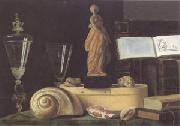 |
Sebastian Stoskopff
|
|
Strasbourg 1597-Idstein 1657
was an Alsatian painter. He is considered one of the most important German still life painters of his time. His works, which were rediscovered after 1930, portray goblets, cups and especially glasses. The reduction to a few objects, which is characteristic of early still life painting, can again be recognized in Stoskopff's painting. His chief works hang in Strasbourg and in Saarbr??cken. Sebastian Stoskopff was born in 1597 in Strasbourg. His father was employed by the city since 1590 and acted as a mounted courier or royal escort, driving a one-horse-carriage. In 1614, Stoskopff's father asked the Strasbourg council for help for his 17-year-old son. He wanted him to be able to learn the craft of painting, since Sebastian had already been extremely talented in drawing and painting since he was 15. The council agreed to provide their support and probably sent the young artist at first to the Strasbourg painter and copper engraver, Friedrich Brentel. However, he only learned how to further refine his drawing and was not, as hoped, introduced to the art of painting. In 1615, Stoskopff's father died and his widowed mother went to the Strasbourg council once again to ask for support for training from a recognized painter. Stoskopff was then sent to Daniel Soreau, a painter who was active in Hanau. In the beginning, Soreau was not very enthusiastic, since he usually chose his apprentices from among his relatives and close friends. However, he finally complied with the request of the council and assured them that would "make an Albrecht Derer of this apprentice". There is not a single definite picture by Daniel Soreau existing. It is only possible to draw conclusions about how well the master passed on his artistic skills to his students through the works of his sons, other apprentices of his workshop and through Stoskopff's works. After Soreau's death in 1619, Stoskopff took over his workshop with the apprentices, as well as his function as the master. One of the apprentices was Joachim von Sandrart, who later became a successful painter and who wrote the first important work on the history of art in the German language: "Teutsche Academie der Bau-, Bild,- und Malerey- Kenste". This work contains descriptions of the lives of earlier and contemporary artists, including descriptions of the time in Hanau with his master, Sebastian Stoskopff. After his attempt to get permission to settle in Frankfurt failed, Stoskopff went to Paris. He stayed there from about 1622 until 1639, which can be reconstructed from indirect reports and property inventories of Parisians. His first works in larger format were also created here, such as "Summer" or "Winter" (now both in Strasbourg). |
|
|
|
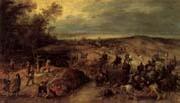 |
Sebastian Vrancx
|
|
Flemish Baroque Era Painter ,
b. 1573, Antwerpen, d. 1647, Antwerpen
Antwerpen,was a Flemish Baroque painter and etcher of the Antwerp school. He was an apprentice in the workshop of Adam van Noort, who also trained many illustrious painters such as Peter Paul Rubens, Jacob Jordaens and Hendrik van Balen. He also visited the workshop of the Antwerp painter Paul Bril in Rome around 1600. He was esteemed as one of the main painters of battle scenes, and works by Vrancx were in the collection of Peter Paul Rubens. As a collaborator he worked at times with Jan Brueghel the Elder. and together with Rubens, Frans Francken the Younger, van Balen, Frans Snyders and Joos de Momper the Younger on the Allegory of the Senses, two works commissioned on the occasion of the archduke Albert of Austria's visit to Antwerp. His best-known student is Pieter Snayers. Most of his pictures represent biblical scenes or scenes of war, such as the sack of towns, cavalry combats, genre paintings and allegorical subjects. Though occasionally vigorous in drawing, his paintings are dull and heavy in tone. He was at the same time a writer of poetry, comedies and tragicomedies for the chamber of rhetoric De Violieren. He was served as dean of the Antwerp painters' Guild of St. Luke, and was a district head and captain of the militia. His works can be found in the Royal Museum of Fine Arts in Antwerp, |
|
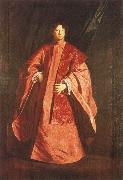 |
Sebastiano Bombelli
|
|
Italian, 1635-1719, Italian painter. He was perhaps the most influential Italian portrait painter of the later 17th century. His early style was formed by his father, Valentino Bombelli, a painter in Udine, and his godfather, the Mannerist artist Girolamo Lugaro. In the early 1660s he was in Venice (Boschini; Sansovino), where he responded passionately to the brilliant colour, painterly freedom and naturalism of 16th-century Venetian artists, particularly Veronese |
|
 |
Sebastiano Conca
|
|
Italian Baroque Era Painter , 1680-1764
was an Italian painter. He was born at Gaeta, then part of the Kingdom of Naples, and apprenticed in Naples under Francesco Solimena. In 1706, along with his brother Giovanni, who acted as his assistant, he settled at Rome, where for several years he worked in chalk only, to improve his drawing. He was patronized by the Cardinal Ottoboni, who introduced him to Clement XI, who commissioned a well-received Jeremiah painted for the church of St. John Lateran. Conca was knighted by the pope. He collaborated with Carlo Maratta in the Coronation of Santa Cecilia in the namesake's church of Santa Cecilia in Trastevere (1721-24). He was elected in 1718 to the Accademia di San Luca and its director in 1729-1731 and 1739-1741. His painting was strongly influenced by the Baroque painter Luca Giordano. Among Conca's pupils were Pompeo Battoni, Andrea Casali, Placido Campoli, Corrado Giaquinto, Gaetano Lapis, Salvatore Monosilio, Literio Paladini, Drancesco Preziao, Rosalba Maria Salvioni, Gasparo Serenari, and Agostino Masucci, He received widespread official acclaim and patronage. He worked for a time for the Savoy family in Turin on the Oratory of San Filippo and Santa Teresa, in the Venaria (1721-1725), for Basilica di Superga (1726), and Royal Palace (1733). He painted frescoes of Probatica, or Pool of Siloam, in the Ospedale di Santa Maria della Scala (hospital) of Siena. In Genoa, he painted large allegorical canvases of the Palazzo Lomellini-Doria (1738-1740). In 1739, he published a guide to painting: Ammonimenti (or Admonishments), which blended moralistic advice with technique. He returned to Naples in 1752, and enjoyed the royal patronage of Charles III. |
|
 |
Sebastiano del Piombo
|
|
1485-1547 Italian Sebastiano del Piombo Galleries
Italian painter. He was one of the most important artists in Italy in the first half of the 16th century, active in Venice and Rome. His early, Venetian, paintings are reminiscent of Giovanni Bellini and to a lesser extent of Giorgione. With his move to Rome in 1511 he came under the influence of Raphael and then of Michelangelo, who supplied him with drawings. After the death of Raphael (1520) he was the leading painter working in Rome and was particularly noted as a portrait painter. In his finest works, such as the Piete (1513; Viterbo, Mus. Civ.) and the Flagellation (1516-24; Rome, S Pietro in Montorio), there is a remarkable fusion of the Venetian use of colour and the grand manner of central Italian classicism. |
|
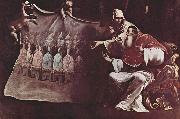 |
Sebastiano Ricci
|
|
(1 August 1659 - 15 May 1734) was an Italian painter of the late Baroque school of Venice. About the same age as Piazzetta, and an elder contemporary of Tiepolo, he represents a late version of the vigorous and luminous Cortonesque style of grand manner fresco painting.
He was born in Belluno, son of Andreana and Livio Ricci. In 1671, he apprenticed to Federico Cerebri of Venice. Others claim Ricci's first master was Sebastiano Mazzoni. In 1678, a youthful indiscretion led to an unwanted pregnancy, and ultimately to a greater scandal, when Ricci was accused of attempting to poison the young pregnant woman to avoid marriage. Imprisoned, he gained release only after intervention of a nobleman, probably a Pisani family member. He married the pregnant mother in 1691, although this was a stormy union.
After his arrest, he moved to Bologna, where he domiciled near the Parish of San Michele del Mercato. His painting style there was apparently influenced by Giovanni Gioseffo dal Sole. On 28 September 1682 he was contracted by the "Fraternity of Saint John of Florence" to paint a Decapitation of John the Baptist for their Oratory. On 9 December 1685, the Count of San Segundo near Parma commissioned from Ricci the decoration of the Oratory of the Madonna of the Seraglio, which he completed in collaboration of Ferdinando Galli-Bibiena by October 1687, receiving a compensation of 4,482 Lira. |
|
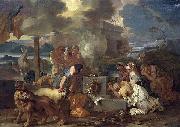 |
Sebastien Bourdon
|
|
(2 February 1616 - 8 May 1671) was a French painter and engraver. His chef d'œuvre is The Crucifixion of St. Peter made for the church of Notre Dame.
The Finding of Moses, c. 1650 (National Gallery of Art, Washington)Bourdon was born in Montpellier, France, the son of a Protestant painter on glass. He was apprenticed to a painter in Paris. In spite of his poverty he managed to get to Rome in 1636; there he studied the paintings of Nicolas Poussin, Claude Lorrain and Caravaggio among his eclectic selection of models, until he was forced to flee in 1638, to escape denunciation by the Inquisition for his Protestant faith. Bourdon's facility rendered him adept at portraiture, whether in a dashing Rubens manner or in intimate, sympathetic bust-length or half-length portraits isolated against plain backgrounds that set a formula for middle-class portraiture for the rest of the century, landscapes in the manner of Gaspar Dughet or cappricci of ruins, mythological "history painting" like other members of Poussin's circle or the genre subjects of the Dutch Bamboccianti who were working in Rome. His eclectic range of styles have given art historians exercise in tracing his adaptation of his models, while the lack of an immediately recognizable "Bourdon style" has somewhat dampened public appreciation.
In 1652 Christina of Sweden made him her first court painter. Bourdon spent most of his working career outside France, where, though he was a founding member of the Academie de peinture et de sculpture (1648), he was for long largely dismissed as a pasticheur, a situation partly rebalanced by a comprehensive exhibition in 2000 of his work at the Musee Fabre, where the collection includes a fine Lamentation painted in the last years of his life.
His success required the establishment of an extensive atelier, where, among his other pupils worked Nicolas-Pierre Loir and Pierre Mosnier. He died in Paris in 1671. |
|
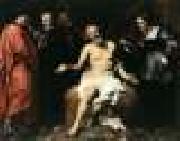 |
SEGHERS, Gerard
|
|
Flemish Baroque Era Painter, 1591-1651
Flemish painter, dealer and collector, active also in Italy and Spain. He grew up in Antwerp, a city that had only recently been liberated from the rebels by the Spanish troops. His father, a keeper of a wine tavern, originally had Calvinist sympathies but returned to the Catholic faith after 1585. Gerard possibly trained, as did afterwards his younger brother Jan Baptist Seghers, who later became a goldsmith, with Gaspar de Crayer (b 1551), the father of the well-known painter of the same name. At the age of 12 Seghers was listed as a pupil in the Guild of St Luke in Antwerp; the documents, unfortunately, fail to mention the name of his teacher. Florent Le Comte (1699) called him a pupil of Abraham Janssen |
|
 |
SEGHERS, Hercules
|
|
Dutch Baroque Era Painter and Printmaker, ca.1590-1638
Dutch landscape painter and etcher. Seghers's work greatly influenced early 17th-century Dutch landscape painting. He studied with the painter Coninxloo (1544C1607) and may have traveled to Italy and in the Alps. Some of the frenzy of his personal life can be seen in his rare paintings and his more numerous, masterly etchings. His landscapes consist of vast, often desolate, panoramas and powerful, smaller scenes rendered with drama and pathos. Rembrandt owned eight paintings by him, and his own landscape style was influenced by Seghers. |
|
|
|
|
|
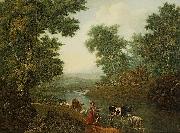 |
Semyon Fyodorovich Shchedrin
|
|
(1745-1804) was a Russian landscape painter, the uncle and mentor of Sylvester Shchedrin.
He was born in St. Petersburg into the family of a life guard. In 1759, he entered the Academy of Arts in St. Petersburg, and in 1765 graduated with a gold medal and grants to study abroad. Shchedrin ventured to Paris, then to Rome. In Paris he studied the works of old and contemporary painters. Under the influence of Rousseau's idea that beauty exists not only in classic patterns of arts but also in everyday life and nature, Shchedrin worked much en plein-air, otherwise known as painting in outdoor environments. In Rome, however, he fell under the influence of classicism, the idea that art should reflect the works of antiquity and thus prolong their successes.
Shchedrin returned to St. Petersburg in 1776 and became a professor of landscape painting in the Academy of Arts. He was assigned to draw views of the palaces and parks of Catherine the Great, which brought into existence such works as View of the Large Pond Island in the Tsarskoselsky Gardens (1777), View of the Large Pond in the Tsarskoselsky Gardens (1777), View of the Farmyard in the Tsarskoye Selo (1777). After 1780, Shchedrin also participated in the restoration of pictures in the Hermitage, and in 1799 he headed a new class of landscape graphics.
The pinnacle of his art career came in the 1790s. The most famous of his works of the period are views of parks and palaces in Pavlovsk, Gatchina, and Petergof: The Mill and the Peel Tower at Pavlovsk (1792), View of the Gatchina Palace from the Silver Lake (1798), View of the Gatchina Palace from Long Island (1798), The Stone Bridge at Gatchina (1799-1801), View of the Kamennoostrovsky Palace through Bolshaya Nevka from the Stroganov Seashore (1803). |
|
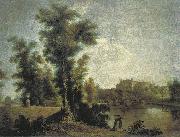 |
Semyon Shchedrin
|
|
(1745-1804) was a Russian landscape painter, the uncle and mentor of Sylvester Shchedrin.
He was born in St. Petersburg into the family of a life guard. In 1759, he entered the Academy of Arts in St. Petersburg, and in 1765 graduated with a gold medal and grants to study abroad. Shchedrin ventured to Paris, then to Rome. In Paris he studied the works of old and contemporary painters. Under the influence of Rousseau's idea that beauty exists not only in classic patterns of arts but also in everyday life and nature, Shchedrin worked much en plein-air, otherwise known as painting in outdoor environments. In Rome, however, he fell under the influence of classicism, the idea that art should reflect the works of antiquity and thus prolong their successes.
Shchedrin returned to St. Petersburg in 1776 and became a professor of landscape painting in the Academy of Arts. He was assigned to draw views of the palaces and parks of Catherine the Great, which brought into existence such works as View of the Large Pond Island in the Tsarskoselsky Gardens (1777), View of the Large Pond in the Tsarskoselsky Gardens (1777), View of the Farmyard in the Tsarskoye Selo (1777). After 1780, Shchedrin also participated in the restoration of pictures in the Hermitage, and in 1799 he headed a new class of landscape graphics.
The pinnacle of his art career came in the 1790s. The most famous of his works of the period are views of parks and palaces in Pavlovsk, Gatchina, and Petergof: The Mill and the Peel Tower at Pavlovsk (1792), View of the Gatchina Palace from the Silver Lake (1798), View of the Gatchina Palace from Long Island (1798), The Stone Bridge at Gatchina (1799-1801), View of the Kamennoostrovsky Palace through Bolshaya Nevka from the Stroganov Seashore (1803). The composition of all of his works is the same in accordance with the rules of academic classicism.
|
|
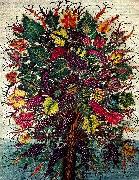 |
seraphine
|
|
Seraphine Louis, known as "Seraphine de Senlis" ("Seraphine of Senlis") (1864?C1942), was a French painter in the naïve style. Self-taught, she was inspired by her religious faith and by stained-glass church windows and other religious art. The intensity of her images, both in color and in replicative designs, are sometimes interpreted as a reflection of her own psyche, walking a tightrope between ecstasy and mental illness. |
|
|
|
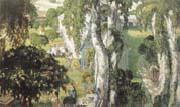 |
Sergei Sudeikin
|
|
Well-known Russian and emigre Symbolist painter, graphic artist, theater and film designer,1882-1946
was a Russian artist and set-designer associated with the Ballets Russes and the Metropolitan Opera. Having been banned from the Moscow School of Painting, Sculpture and Architecture for his "obscene drawings", Sudeikin joined the Mir Iskusstva movement. His close friends included the poet Mikhail Kuzmin and the impresario Serge Diaghilev, at whose invitation he came to Paris in 1906 for the Salon d'Automne Exhibition, where his work was first shown abroad. In 1907-1918, he was married to actress Olga Glebova (1885-1945), one of the famed beauties of St Petersburg and the closest friend of Anna Akhmatova. Glebova-Sudeikina is the principal character and addressee of Akhmatova's longest work, "The Poem Without Hero" (1940-65). Sudeikin designed the sets and costumes for Diaghilev's production of La trag??die de Salome by Florent Schmitt in 1913, and assisted in the execution of Nicholas Roerich's designs for Stravinsky's The Rite of Spring the same year. By the time of the October Revolution Sudeikin was among the foremost theatrical designers in Russia. |
|
|
|
|
|
|
|
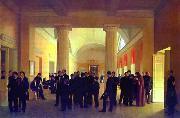 |
Sergey Zaryanko
|
|
Sergey Konstantinovich Zaryanko (1818 - 1871) was a Russian painter, he was as a pupil of Venetzianov |
|
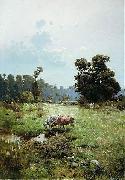 |
Serhii Vasylkivsky
|
|
(October 19, 1854, Izium e October 7, 1917, Kharkiv) was one of the most prolific Ukrainian artists of the pre-revolutionary period and an expert on Ukrainian ornamentation and folk art.
Vasylkivsky grew up in an environment conducive to his development as an artist. He was born and spent his childhood in the picturesque surroundings of Izium, a city in the historical region of Sloboda Ukraine, and today's Kharkiv Oblast. The future painter had a chumak grandfather whose roots reached cossack ancestral lines. Vasylkivsky's father was a writer and taught his son the aesthetics of proper calligraphy. His mother, through her folk songs set the foundation which provided the inspiration for Vasylkivsky's art later in life.
When he was seven years old, his parents moved to Kharkiv, which at the time was a significant cultural center of Sloboda Ukraine. Vasylkivsky's first art lessons were given at the Kharkiv gymnasium by Dmytro Bezperchy, a student of Karl Briullov. During the years of his study, Vasylkivsky was able to use the extensive book collection of his relative and poet, V. Alexandrov. Among these were the works by Ivan Kotlyarevsky, Taras Shevchenko, and Nikolai Gogol, which made a strong impression on the young artist. After five years of education at the gymnasium and at the demand of his father, Vasylkivsky began studies at the Kharkiv Veterinary School. This lasted until 1873, when Vasylkivsky left veterinary studies due to his parents inability to pay for tuition. For a while, he worked as a civil servant in Kharkiv.
|
|
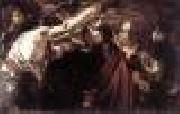 |
SERODINE, Giovanni
|
|
Italian Baroque Era Painter, 1600-1630
Italian painter and stuccoist. His family moved from Ascona on Lake Maggiore to Rome, where his father is recorded in 1595. It is probable that Serodine was born there. His first work was probably done in association with his brother Giovanni Battista Serodine (1589/90-1630), a stuccoist active in Rome, where he carved a Virgin and Child (1614) for the fa?ade of S Francesca Romana, and in Ascona, where he restored the family home and decorated it with stucco (1620). The design and stucco decoration of the church of the Madonna della Fortuna on Monte Verit? (Ascona) are attributed to him, though it is probable that Giovanni (who is recorded in Ascona in 1620) collaborated in the work. The first of Giovanni's documented official commissions, however, was for the stucco decoration and apsidal paintings in the chuch of the Concezione at Spoleto, where he worked with Sante Ghezzi (Corradini; Toscano). These murals, painted in tempera and completed in July 1624, are sketchy and clumsily executed, quite distinct in their inferior quality and naive piety from the rest of Serodine's work. They are probably his first attempts at painting, |
|
|
|
|
|
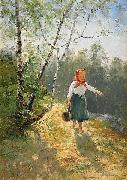 |
Severin Nilsson
|
|
(1846 - 1918) was a Swedish painter and photographer.
He was born in Halland in the south of Sweden. He studied at the Royal Swedish Academy of Arts in Stockholm 1865 - 1871 and then under Leon Bonnat in Paris for three years.
Severin painted portraits, landscapes and genre pictures. A prolific artist, he participated in numerous exhibitions and left behind a large and diverse production of work. He was also one of the first Swedish documentary photographers. Inspired by Arthur Hazelius, he made photographic studies of public life, especially in the village Asige in Halland, where he was born
|
|
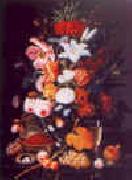 |
Severin Roesen
|
|
1848-1871
Severin Roesen (ca. 1815-1872) is a painter known for his abundant fruit and flower still lifes and is today recognized as one of the major American still-life painters of the mid-nineteenth century. Born in Cologne, in Germany, he emigrated to the United States in 1848.
While Roesen's paintings reveal a meticulous attention to detail in their precise arrangements and close brushwork, his subject matter, even down to specific motifs, did not change throughout his career. Sometimes he made near copies of paintings, but usually he merely rearranged and reassembled stock elements.
Numerous items in Fruit and Wine Glass, for example, also appear in other paintings. The footed desert plate full of strawberries is a common motif. The pilsner glass, sometimes accompanied by an open bottle of champagne, is interchangeable with a wine goblet filled with lemonade used elsewhere. The glass is nearly always placed at the lower left edge of the painting; a halved lemon often appears nearby. Branches full of grapes arranged from lower left to upper right provide the composition with a graceful S-curve and subtly lead the viewer's eye over the entire display. Here the composition is balanced by light and dark grapes at either side and filled in by scattered raspberries, cherries, peaches, apples, pears, and apricots. Many of these compositional elements, if not the items depicted, were derived from seventeenth-century Dutch still life paintings by such artists as Jan van Huysem. |
|
|
|
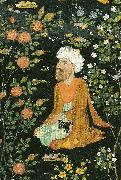 |
shah-u-gada
|
|
In Vishnudharmottara Purana, Kubera is described as the embodiment of both Artha ("wealth, prosperity, glory") and Arthashastras, treatises related to it and his iconography mirrors it. Kubera's complexion is described as that of lotus leaves. He rides a man - the state personified, adorned in golden clothes and ornaments, symbolizing his wealth. His left eye is yellow. He wears a armour and necklace upto his large belly. His face should be inclined to the left, sporting a beard and moustache and with two small tusks protruding from the ends of his mouth, representing his powers to punish and bestow favours. His wife Riddhi - representing the journey of life - is seated on his left lap, with her left hand on the back of Kubera and right holding a ratna-patra ("jewel-pot"). He should be four-armed, holding a gada (mace - symbol of dandaniti - administration of justice) and a shakti (power) in his left pair and standards bearing a lion - representing artha and a shibika (a club, the weapon of Kubera). The nidhi treasures Padma and Shankha stand besides him in human forms with their heads emerging from a lotus and a conch respectively. Agni Purana states that Kubera should be installed in temples as seated on a goat with club in his hand. Kubera's image is prescribed to be of gold with multi-coloured attributes |
|
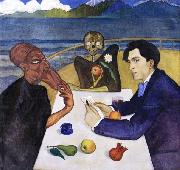 |
Shalva Kikodze
|
|
Shalva Kikodze (Georgian: შალვა ქიქოძე) (1894 - 1921) was a Georgian expressionist painter, graphic artist and theatre decorator. Together with Lado Gudiashvili and David Kakabadze, he is considered a key figure in Georgian art of the early 20th century.
He was born in a remote Georgian village Bakhvi, Guria, then part of the Russian Empire. From 1914 to 1918, he studied at Moscow School of Painting, Sculpture and Architecture. In 1916, he took part in an expedition to the Georgian village Nabakhtevi and made copies of the 15th-century murals from the local church. He stayed in his motherland for a short period of 1918-1920, and worked chiefly as a theater decorator for Jabadari Theater in Tbilisi. Afterwards he moved to Paris, where he, together with his fellow painters, Gudiashvili and Kakabadze, held an exhibition in 1921. He died in Freiburg, Germany, on November 7, 1921
|
|
|
|
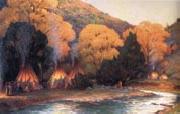 |
Sharp Joseph Henry
|
|
American Painter, 1859-1953
was a painter credited with influencing the creation of the Taos, New Mexico Society of Artists. Sharp may have been the first artist to discover Taos when he visited in 1883. He painted American Indian portraits and cultural life, and Western landscapes. As a youth he permanently damaged his hearing in a near-drowning accident, and gradually become totally deaf. His formal art training included Mckmicken School of Design (Cincinnati) and Antwerp (Belgium) Academy. He traveled and worked in Europe also. Harpers Magazine commissioned his illustrations of Taos Indian life. Some portraits were purchased by the Smithsonian Institution. President Theodore Roosevelt took an interest in him and had a cabin built for him at Little Big Horn to paint Indian life there. |
|
|
|
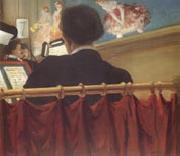 |
Shinn Everett
|
|
American Ashcan School Painter, 1876-1953
American painter, illustrator, designer, playwright and film director. He studied industrial design at the Spring Garden School in Philadelphia from 1888 to 1890. In 1893 he became an illustrator at the Philadelphia Press. Simultaneously he attended the Pennsylvania Academy of Fine Arts, Philadelphia, where he met Robert Henri, John Sloan, William J. Glackens and George Luks. Their style of urban realism prompted him to depict the bleak aspects of city life. In 1897 Shinn moved to New York and produced illustrations for several newspapers and magazines |
|
|
|
 |
SIBERECHTS, Jan
|
|
Flemish Baroque Era Painter, 1627-1703
Flemish painter, active in England. He was the son of the sculptor of the same name and became a master in the Guild of St Luke in Antwerp by 1648. He married in 1652 and moved to England sometime between 1672 and 1674. |
|
|
|
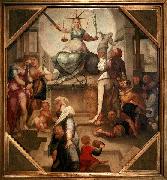 |
Sienese school
|
|
The Sienese School of painting flourished in Siena, Italy between the 13th and 15th centuries and for a time rivaled Florence, though it was more conservative, being inclined towards the decorative beauty and elegant grace of late Gothic art. Its most important representatives include Duccio, whose work shows Byzantine influence; his pupil Simone Martini; Pietro and Ambrogio Lorenzetti; Domenico and Taddeo di Bartolo; Sassetta and Matteo di Giovanni. Unlike the naturalistic Florentine art, there is a mystical streak in Sienese art, characterized by a common focus on miraculous events, with less attention to proportions, distortions of time and place, and often dreamlike coloration. In the 16th century the Mannerists Beccafumi and Il Sodoma worked there. While Baldassare Peruzzi was born and trained in Siena, his major works and style reflect his long career in Rome. The economic and political decline of Siena by the 16th century, and its eventual subjugation by Florence, largely checked the development of Sienese painting, although it also meant that a good proportion of Sienese works in churches and public buildings were not discarded or destroyed by new paintings or rebuilding. Siena remains a remarkably well-preserved Italian late-Medieval town.
|
|
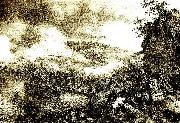 |
sigismund vasa
|
|
1566-1632, vars rattmatiga dynastiska krav pa den svenska tronen gjorde honom till en livslang fiende med kusinen gustav ll adolf. |
|
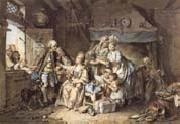 |
Sigmund Freudenberger
|
|
Swiss, 1745-1801,Swiss painter, draughtsman and engraver. In 1761 he went to work for the portrait painter Emanuel Handmann in Basle, where he stayed for three years. In 1765, with Adrian Zingg (1734-86), he left for Paris, where he trained with Jakob Schmutzer (1733-1811) and frequented the studio of Jean Georges Wille, the celebrated engraver. He worked as a book illustrator during this period. The work of Boucher, whom he met, and of Greuze and Fragonard had a significant influence on his artistic development. Freudenberger returned in 1773 to Berne, where he undertook several portraits. He became friendly with Johann Ludwig Aberli, with whom he travelled the countryside, which he recorded in numerous drawings, watercolours and engravings. He specialized in genre scenes, rustic still-lifes and portrayals of Bernese peasant life, which became very popular. In some works, such as a red chalk drawing of A Woman Playing the Harp (1778; Zurich, Schweizer. Landesmus.), he continued the gallant style he had learnt from Boucher. His watercolours were frequently engraved, either individually or in series, and hand-coloured. His style is characterized by detailed and careful execution and by an intimate, narrative approach, although he tended to idealize his rustic subject-matter. His work was significant in introducing genre subjects in Switzerland, where artists had tended to concentrate on pure landscape. He ran a large studio where Daniel Lafond (1763-1831), Niklaus Kenig and Georg Mind (1768-1814) were pupils. The French Revolution was disastrous for his art and his business and clouded the last years of his life. |
|
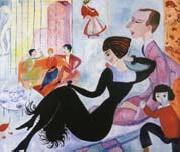 |
Sigrid Hjerten
|
|
Swedish, 1885-1948,
was a Swedish modernist painter. Hjerten is considered a crucial figure in Swedish modernism. Periodically she was highly productive and she participated in a large number of exhibitions. She worked as an artist for 30 years before succumbing to complications from treatment for a psychiatric disorder. Sigrid Hjerten was born in Sundsvall in 1885. She studied at the College of Crafts and Design in Stockholm and graduated as a drawing teacher. At a studio party in 1909, Herten met her future husband, twenty-year old Isaac Grenewald, who had already studied one year with Henri Matisse in Paris. Grenewald convinced her that she would do herself more justice as a painter. Later that year she went to Matisse's art school as well. 1910s As she studied under Henri Matisse in Paris, she was impressed by the way he and Paul Cezanne dealt with colour. This shows in her painting in contrasting colour fields and simplified contours, her way of achieving the greatest possible expressiveness. Her aesthetic intentions had primarily to do with colour, and in her later works from the 1930s she spoke of colours in terms such as cold yellow. Hjerten strove to find forms and colours that could convey her emotions. In that respect her work is more closely related to the German Expressionists, such as Ernst Ludwig Kirchner, than to the French painters, with their graceful play of lines. After a year and a half she returned to Sweden. In 1912 Sigrid Hjerten participated in a group show in Stockholm. In the following ten years she took part in several exhibitions both in Sweden and abroad, among other places in Berlin in 1915, where she was well received. Sigrid Hjerten was also represented at the Expressionist Exhibition at the Liljevalch's konsthall in Stockholm in 1918, together with two other artists. However, most of the critics then were writing scathing reviews about her art. In Hjerten's art, where she greatly exposes herself, one notices different stages of development. The influence of Matisse is perhaps mostly discernible in the 1910s. During this decade, Hjerten created many paintings with indoor pictures and views from her home, first at Kornhamnstorg Square and later at Katarinavägen Street, in Stockholm. Her husband Isaac Grenewald and her son Iven, as well as Sigrid herself, are often depicted in scenes that embrace various sorts of conflicts. At this time Sigrid Hjerten got acquainted with and inspired by the art made by Ernst Josephson during his illness. Ateljeinteriör (Studio interior) from 1916 shows how radical Hjerten was for her time. The painting describes the roles she played as artist, woman, and mother: different identities in different worlds. Hjerten sits on the sofa between two artists - her husband, Isaac Grenewald, and Einar Jolin - who talk to each other over her head. Her large blue eyes stare into the distance. In the foreground a woman dressed in black-a sophisticated alter ego-leans against the artist Nils von Dardel. Her son Iven crawls out of the right-hand corner. In the background we glimpse one of Hjerten's paintings of the period, Zigenarkvinna (Gypsy woman). Studio Interior and Den röda rullgardinen (The red blind) from 1916, are daring paintings that have given rise in recent years to new interpretations based on contemporary gender studies and revealing information about the artist's life. For long periods Sigrid Hjerten lived alone with her son and a sister of her husband. Sigrid and Isaac seem to have been very attached to one another, but their marriage met with great problems. Sigrid apparently had difficulties with her identity as a woman and in combining her different roles as a mother, a wife and an artist. The conflicts of her life made a mark in her painting. 1920s Between 1920 and 1932, Sigrid Hjerten lived in Paris, and made many excursions to the French countryside and the Italian Riviera for painting. This was a relatively harmonious era in Hjerten's art, but her exhibits were very limited in this period. Her husband, Isaac, mostly lived in Stockholm where he had a brilliant career. In the late twenties Hjerten increasingly suffered from various psychosomatic ailments, and she complained of loneliness. As time passed, an increasing tension can be seen in her art that successively rises and reaches its height immediately before the disease forces Sigrid Hjerten to cease as an artist. In the late twenties, while she was very isolated in France, colder and darker colours began to show. Recurring diagonal strokes helped to give the paintings a tense impression. During the thirties Hjerten painted innovative paintings which are characterized by menacing tones, growing storm clouds, and feelings of abandonment. 1930s In 1932, Sigrid Hjerten decided to return to Stockholm. But during packing she collapsed. She got to Sweden and was temporarily taken to the psychiatric hospital of Beckomberga with symptoms of schizophrenia. She recovered periodically and in the two following years (1932 C1934) Hjerten's artistry culminated in a crescendo, where, like one possessed, she made pictures that expressed strongly loaded feelings. One gets the impression that she tried to master a threatening inner chaos with her creative work. She devoted herself to intensive painting, creating one picture a day, the picture-book of her life, according to an interview in the Swedish art magazine Paletten. Some paintings radiate horror while others give a warm and harmonious impression. During 1934, she traveled with her family in the south of Europe, where she painted. Sigrid Hjerten eventually made her name as an artist among the critics in 1935, when she exhibited with Isaac and Ivan in Gothenburg. Yet, most contemporary critics had a negative and even scornful attitude towards Sigrid Hjerten's works of art, and many of them wrote deeply offensive reviews. Among other things her paintings were called idiocy, humbug, horrors and products of handicap. She won public recognition only in 1936, when she had a well received solo exhibition at the Royal Swedish Academy of Arts in Stockholm. Isaac, who had many mistresses over the years, divorced Sigrid and remarried. (Both Isaac and his new wife later died in a flying accident in 1946). At that time, Sigrid suffered from escalating mental illness, diagnosed with schizophrenia, and was permanently hospitalised at Beckomberga Psychiatric Hospital in Stockholm, where she remained for the rest of her life. After 1938 her artistic output dwindled. Following a botched lobotomy, she died in Stockholm in 1948. |
|
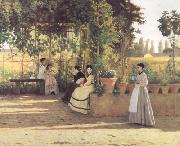 |
Silvestro lega
|
|
Italian Realist Painter, 1826-1895
Italian painter. From 1843 to 1847 he attended the Accademia di Belle Arti, Florence, studying drawing under Benedetto Servolini (1805-79) and Tommaso Gazzarini (1790-1853), then, briefly, painting under Giuseppe Bezzuoli. About 1847 he entered Luigi Mussini's school (see PURISMO), where the teaching emphasized the 15th-century Florentine principles of drawing and orderly construction. Then and for some years afterwards he continued to attend the Scuola del Nudo of the Accademia. After fighting in the military campaigns for Italian independence (1848-9) Lega resumed his training, this time under Antonio Ciseri, executing his first large-scale painting, Doubting Thomas (1850; Modigliana, Osp. Civ.). In 1852 he won the Concorso Trienniale dell'Accademia with David Placating Saul |
|
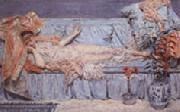 |
Simeon Solomon
|
|
English Pre-Raphaelite Painter, 1840-1905
was an English Pre-Raphaelite painter. Solomon was born into a prominent Jewish family. He was the eighth and last child born to merchant Michael (Meyer) Solomon and artist Catherine (Kate) Levy. Solomon was a younger brother to fellow painters Abraham Solomon (1824?C1862) and Rebecca Solomon (1832?C1886). Born and educated in London, Solomon started receiving lessons in painting from his older brother around 1850. He started attending Carey's Art Academy in 1852. His older sister first exhibited her works at the Royal Academy during the same year. As a student at the Royal Academy Schools, Solomon was introduced through Dante Gabriel Rossetti to other members of the Pre-Raphaelite circle, including the poet Algernon Charles Swinburne and the painter Edward Burne-Jones in 1857. His first exhibition was at the Royal Academy in 1858. He continued to hold exhibitions of his work at the Royal Academy between 1858 and 1872. In addition to the literary paintings favoured by the Pre-Raphaelite school, Solomon's subjects often included scenes from the Hebrew Bible and genre paintings depicting Jewish life and rituals. Solomon lived as an openly gay man in a time when it was not socially acceptable to do so,[1] but in 1873 his career was cut short when he was arrested in a public urinal at Stratford Place Mews, off Oxford Street, in London and charged with indecent exposure and attempting to commit sodomy. He was sentenced to serve eighteen months' hard labour in prison, but this was later reduced to police supervision. He was arrested again in 1874 in Paris, after which he was sentenced to spend three months in prison. In 1884 he was admitted to the workhouse where he continued to produce work; however, his life and talent were blighted by alcoholism. Twenty years later in 1905, he died from complications brought on by his alcoholism. He was buried at the Jewish Cemetery in Willesden. |
|
 |
Simon Vouet
|
|
French
Simon Vouet Gallery
1590-1649
French painter and draughtsman. Although at the time regarded as one of the leading French painters of the first half of the 17th century, he is now known more for his influence on French painting than for his actual oeuvre. He made his reputation in Italy, where he executed numerous portraits for aristocratic patrons and was commissioned for religious subjects. Although the early Italian works show the influence of Caravaggio, his work was subsequently modified by the Baroque style of such painters as Lanfranco and the influence of the Venetian use of light and colour. When he was summoned back to France by Louis XIII in 1627 he thus brought with him an Italian idiom hitherto unknown in France that revitalized French painting.
|
|
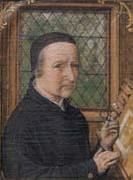 |
Simon Bening
|
|
Flemish Northern Renaissance Manuscript Illuminator, ca.1483-1561
was a 16th century miniature painter of the Ghent-Bruges school, the last major artist of the Netherlandish tradition. Bening was trained in his father Alexander Bening's miniature painting workshop in Ghent. He made his own name after moving to Bruges. His specialty was the book of hours, but by his time these were becoming relatively unfashionable, and only produced for royalty and the very rich. He also created genealogical tables and portable altarpieces on parchment. Many of his finest works are Labours of the Months for Books of Hours which are largely small scale landscapes, at that time a nascent genre of painting. In other respects his style is relatively little developed beyond that of the years before his birth, but his landscapes serve as a link between the 15th century illuminators and Peter Brueghel. His self-portrait and other portraits equally are early examples of the portrait miniature. He served as dean of the calligraphers, booksellers, illuminators, and bookbinders in the Guild of Saint John and Saint Luke. He created books for German rulers, like Cardinal Albrecht of Brandenburg, and royalty like Emperor Charles V and Don Fernando, the Infante of Portugal. The artistic tradition continued in his family. His eldest daughter, Levina Teerlinc |
|
 |
Simon de Vlieger
|
|
Dutch
1600-1653
Dutch painter, draughtsman, etcher and stained-glass designer. He was one of the leading marine and landscape artists of the Dutch school and decisively influenced the direction of Dutch marine art during the 1630s and 1640s. His late works anticipated the shift from the monochrome or tonal phase of Dutch marine art to the more classical style of Jan van de Cappelle and Willem van de Velde the younger (see MARINE PAINTING). Although de Vlieger reputation rests chiefly on his marine paintings, he was also a notable draughtsman and etcher.
|
|
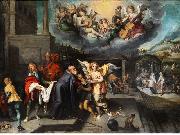 |
Simon de Vos
|
|
Simon de Vos (Antwerp, 20 October 1603-15 October 1676, Antwerp) was a Flemish Baroque painter of genre and cabinet pictures.
De Vos studied with Cornelis de Vos (1603-76), to whom he is not related, from 1615 until 1620. In 1620 he joined Antwerp's guild of St. Luke, and then he probably travelled to Rome where he came under the influence of the "low-life" genre paintings of the Bentvueghels and the bambocciate. A Caravaggesque influence, by way of the German painter Johann Liss active in Italy during the 1620s is discernible in De Vos's paintings from this time on. In contrast to the earlier "low-life" paintings, works from the late 1620s until around 1640, which were made after returning to Antwerp, are mostly small "merry company" and courtly genre scenes reminiscent of contemporary Dutch painters Dirck Hals and Pieter Codde. After 1640, De Vos turned away from genre scenes altogether and painted mostly small cabinet paintings of history subjects, influenced stylistically at first by Peter Paul Rubens and then increasingly by Anthony van Dyck. Examples include The Beheading of St. Paul (1648) in the Royal Museum of Fine Arts, Antwerp.
He married Catharina van Utrecht, the sister of Adriaen van Utrecht, in 1628. |
|
|
|
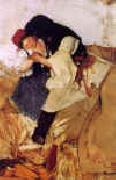 |
Simon Hollosy
|
|
1857-1918
Hungarian Simon Hollosy Gallery
Simon Hollosy (Romanian: Simion Corbu); (2 February 1857, Maramarossziget, now Sighetu Marmatiei - 8 May 1918, Tecso, now Tiachiv) was a Hungarian painter. He was considered one of the greatest Hungarian representatives of 19th century Naturalism and Realism.
Holl??sy came from an Armenian family who settled in Maramarossziget (present-day Sighetu Marmaţiei, Romania). He frequently worked abroad.
He criticized training at the Academy and founded a private school in 1886 where he gathered young talents around him who were interested in realistic protrayal. He opened the way to new styles by relying on his personality and by pointing out the merits of French pictures (Courbet) exhibited in Munich. He abandoned the academic style in order to follow new trends in French painting.
Encouraged by Istvan Reti and Janos Thorma, his pupils and friends, he spent the summer of 1896 in Nagyb??nya (present-day Baia Mare, Romania) with his school, which played an important role in Hungarian painting as the cradle of the Nagybanya school. He soon settled down in Nagybanya. With its style (sunny landscapes), his school determined Hungarian painting for decades. Leaving the Nagyb??nya colony in 1901, he spent the summers in Tecso with his students from 1902. During winters he was in Munich to run his school there.
He was not productive as an artist: he was in search of atmospheres and his productivity was confined to teaching. His large scale plan of "Rakoczi March" with a lot of figures got as far sketches because he kept on changing his mind. The landscapes painted in Tecso include "Landscape in T??cső", "Landscape with Stacks and Sunset with Stacks", where he applied elements of plein air and impressionism.
His self-portrait (1916) is one of his most harrowing pictures. |
|
|

